A New Windows - Windows 10 Announced By Microsoft
by Brett Howse on September 30, 2014 4:25 PM EST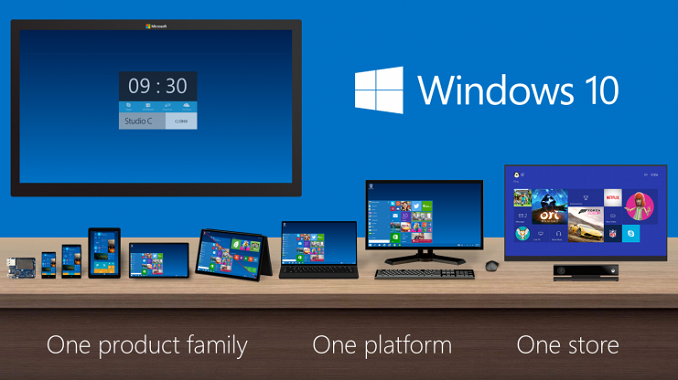
It was only two years ago that Windows 8 was unleashed on the world. Microsoft tried to usher in an era of “Touch First” applications with a new look and feel for Windows. To say that Windows 8 was unsuccessful would be an understatement, and from both Microsoft’s and user’s perspectives, it was certainly a failure. Two years in, Windows 8 and its 8.1 derivative have struggled to gain market share over Windows 7 and XP, which still command the lion’s share of the desktop OS pie. A new interface, unfamiliar to users, did little to sway their wallets, and other market factors have come in to play as well.
Looking back at Windows 8, it was a big change from a company that traditionally has been called too conservative. Gone was the familiar start menu, replaced with a full screen version. Gone was the ability to move and resize applications into “windows” and instead it was replaced with full screen apps that take command of your desktop. Gone was a lot of what made Windows, well Windows. Add in the fact that Windows 8 at its launch was only half complete, and it is not surprising that the market did not buy into the new world. There were two disjointed interfaces, but one person had to interact with both no matter what form factor they were on. If you are on a touch based tablet, much of the settings and controls were still found in the old Control Panel applets. The file explorer was on the desktop, which was difficult to use with touch. On the other side of the coin, traditional desktop PC users also had to learn the new Start Screen, charms, and other controls which were clearly made for “touch first” and not the mouse and keyboard. Within weeks of the Windows 8 launch, major players in its creation were let go, or given new duties.
Since the day one release of Windows 8, Microsoft has been trying to fix many of the issues people have with the new version of their operating system, and Windows 8.1 was a step in the right direction, fixing interfaces for both the touch interface and the desktop. Windows 8.1 Update, announced at BUILD earlier this year, was a truly desktop-centric update with new keyboard and mouse controls for use in the touch environment, and the ability to control Windows Store apps with a title bar. It was a big help, but also showed off at BUILD were features coming in a later version of Windows, and that version has now come.
Windows 10 is as dramatic a shift from Windows 8 as Windows 8 was to Windows 7. Gone is the start screen for the desktop, with the familiar start menu back. Gone is the full screen applications taking over your computer, with those applications now being relegated to windows as before. Gone is the touch first interface on top of an operating system primarily used with a keyboard and mouse. However this is not Windows 7.1, and nor should it be. Windows 8 certainly had its faults, but not everything about Windows 8 needed to be thrown out.
Windows 10 starts its journey as the Windows Technical Preview for Enterprises. Microsoft’s core customer base is the enterprise, and this is important that they are starting the discussion with this market group this time around. Beginning tomorrow, people can join the Windows Insider Program and download and install the latest version of Windows for themselves. Microsoft has made it clear though that this preview is actually a preview, and not meant for general availability. Expect some rough edges, and some bugs, which should be worked out by the time the OS ships. As for the consumer side of the story, Microsoft is planning to announce more on that front in early 2015, and for developers, BUILD will be coming sometime after that. The actual Windows 10 launch is listed as “later in the year” with the year being 2015.
There is a lot to go over, and once we get our hands on the preview build we can dig into the new OS and give a full breakdown on what is new. One of the biggest complaints about Windows 8 and 8.1, is that real people do not want a single interface on every device they own. They want a User Interface which is tailored to the usage model. With Windows 10, Microsoft promises to address this.
Before we can talk about Windows though, we need to briefly discuss the Windows Store. Windows Store apps are executed in WinRT, which is the Windows RunTime, replacing the old Win32 runtime. WinRT has some advantages as a new framework, with the ability to be resolution independent natively, and support the Windows contracts such as Share. At BUILD in 2014, Microsoft announced Universal Apps, which are a key feature of the Windows store that is not available on any other platform. There is a lot of confusion as to what a Universal App is, and what it is not is a single application that runs on a phone, PC, tablet, and console. A Universal App leverages the common WinRT framework available in Windows, Xbox One, and Windows Phone, to allow a developer to share a common code base, but use a suitable UI for each system, and have all of it available on all platforms seamlessly through the Windows Store. It is certainly a lofty idea, and one that has gained a bit of traction in the store. With Windows 10 though, the concept of a Universal App allows a developer to target a phone, Xbox, tablet, and desktop. If anything is the killer feature of Windows 10, this could be it. Time will tell of course and developers need to buy into WinRT for this to be a reality. Today’s announcement is not developer focused, so we will expect more news on the WinRT API updates later on, at the BUILD conference.
The first place to start, is going to be Start. On Windows 7, clicking the Start button brought up the Start Menu. Windows 8 dropped the start button altogether, but 8.1 brought it back even though it opened the Start Screen. On tablets, the start screen was fine, but on a desktop, it could be unwieldy. It interrupted your workflow to bring you into a new environment, where you can find the application you want and launch it. Windows 10 brings back the Start Menu, but with a twist. Rather than just the traditional start menu of Windows 7, a familiar start menu can now also be populated with Live Tiles from the Windows Store apps. But this is only on the desktop. Tablets will get a different interface, as will the phone. To quote Microsoft: “We’re not talking about one UI to rule them all – we’re talking about one product family, with a tailored experience for each device.”
If Windows 10 is going to be successful, the tailored experience for each device is the key. The new start menu is just the first step towards that, and is especially important for the enterprise and desktop user.
The next interface change, was also announced at BUILD, and that is the ability to run Windows Store apps within a window on the desktop. This is a big change for two reasons. First, on a desktop, full screen Windows Store apps are less useful. Generally you have multiple things going on at once, and to have a single app take over the screen is generally not ideal. The usefulness of Windows Store apps has instantly been increased. The other reason it is important is for developer buy-in. Even though Windows 8 did not light the world on fire as far as unit sales, it is still on hundreds of millions of devices. However the majority of those devices are going to be traditional desktops. Writing an application for the Windows Store practically precluded use by the majority of the user base. By putting these apps on the desktop, it opens up a much larger potential audience. Microsoft needs the Windows Store to be kick-started, and this is one way they can advance that goal.
Windows Snap was also debuted in Windows 8, and it allowed two Windows Store apps to be snapped open, with one taking about 70% of the screen and the other using 30%. For multitasking, it was certainly better than other mobile operating systems from 2012, but it was a long way from Windows 7. Windows 8.1 improved Snap, and allows more than two apps to be snapped open on the screen at any one time, and for the snap percentage to be changed. Windows 10 is now offering another update on Snap. Apps can now be snapped to all four corners, giving more real estate to each app than before. Snap was a good feature, and this is a further improvement on it.
Another long requested feature is now coming to Windows 10 – multiple desktops. Desktops can be designated for different purposes, and users will be able to easily switch among them. There is a small but vocal group who have been asking for this for a long time, and they have finally been rewarded.
Sticking with the enterprise features, data security is always a big concern. Multifactor authentication based on smart cards or tokens is now built right into the OS. Bitlocker is still around, offering full device encryption, but Windows 10 now offers application and file level data separation, which can enable data protection even if that data leaves the device. Though they have not gone into a lot of detail as to how that is done, it likely leverages some of Microsoft’s other technologies such as Active Directory Rights Management Services.
Future updates to Windows should be easier for IT workers as well due to a new in-place upgrade option. And to go along with that, businesses will be able to choose whether to jump on the fast update consumer track, or lock down the updates to only deliver critical security patches, or somewhere in the middle. And this approach does not need to be at the enterprise level – different groups of machines can follow different update patterns depending on how critical the infrastructure is.
Windows 10 also supports Mobile Device Management (MDM) tools, as well as the traditional Active Directory and System Center approach to device management. This should be a boon to any small to mid-sized business who does not want to invest in a comprehensive solution.
Finally, the new Windows Store will allow volume license purchasing from within the store. Companies can re-claim licenses, and re-issue them to new devices. They can also create a custom store for their own computers which can include Windows Store and company-owned apps in the same interface.
Microsoft is trying hard to win back the Enterprise customers who have been turned off by Windows 8. Obviously we will have to wait and see if they are successful, but there is a lot to like in this new release. The “one UI to rule them all” model of Windows 8 has been put out to pasture, and instead replaced with a single platform, with a UI to suit the device it is running on.
Not all was bad about Windows 8, and it is good to see that some of the good ideas have been taken and molded into the new OS, but also tweaked at the same time to make them work better for the device they are on. The Universal App is a powerful idea, and one that has yet to make a big splash so far, but if the WinRT framework can be updated to make it more powerful, then it would certainly add a lot of power to Windows 10. Unlike Win32, WinRT apps support high DPI by default, which is more and more important as we move to higher resolution displays on all sizes of devices. The ability to log in to any Windows PC and get your own custom look and feel, including all of your applications, and data, is a powerful feeling. They have all of the tools they need to do this across all devices now, and it is exciting to see a glimpse at what the future may hold.
Once we get the actual install files for Windows 10, we will be able to provide more coverage on this major release of Windows.



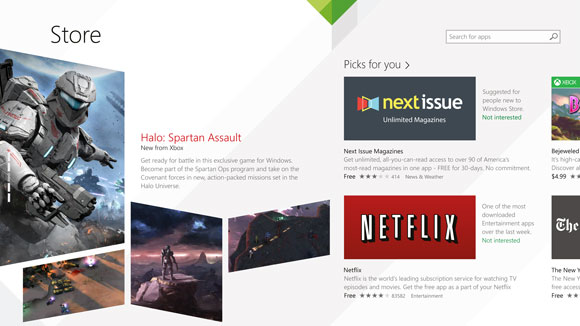
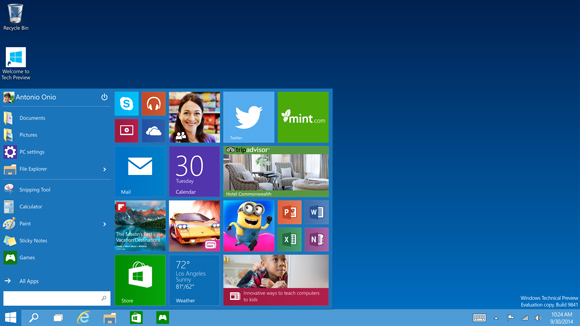
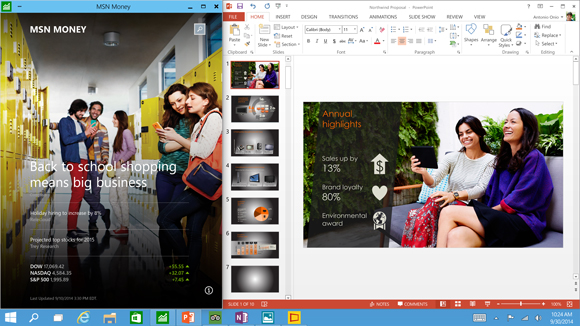
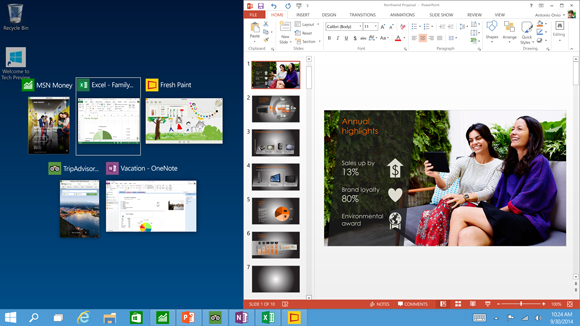
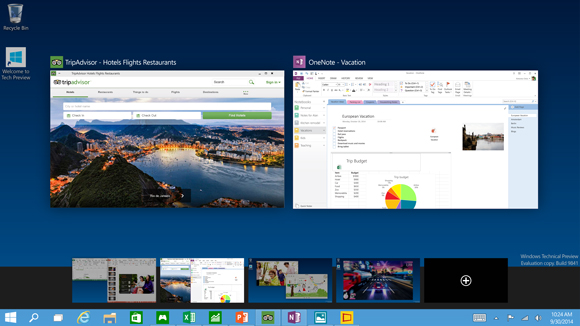









134 Comments
View All Comments
sigmatau - Thursday, October 2, 2014 - link
They took all those mundane items to make Windows work on light devices. Now you can have the same Windows on a tablet as a desktop. It was not possible with the GPU requirements of Aero.All you are complaining about is the look which is very simple minded. They did so much under the GUI that makes Windows 8 far better than 7, never mind what 10 will bring. New file system, new recovery options, apps that update during sleep, and many more.
But hey, keep complaining about the most useless aspects of the OS.
inighthawki - Thursday, October 2, 2014 - link
"It was not possible with the GPU requirements of Aero."Even in Windows 7, aero glass could be turned off with the click of a button. In fact, it turns out that's basically all they did with Windows 8 - It was disabled and couldn't be turned on. Unfortunately 8.1 later removed it entirely.
You're also making it seem like my only reason for complaining about the UI is that I "think it's ugly". That is not true. I've explained this multiple times. There are actual objectively poor choices made in the visual style of Window s8 that can lower productivity, including, but not limited to, color choices, contrast around edges, drop shadows, etc.
And I also never shamed Windows 8 for under the hood changes. They're great. But I'm referring specifically to UI issues. The problem is that the shell of an OS is the #1 reason, by far, for whether or not people choose to adopt a platform. Despite my complaining, I use Windows 8. I us eit every day, I don't have any Win7 machines. I use it because I'm able to look past my complaints for those under the hood changes and improvements. That doesn't, for a second, mean that I'm happy with my experience with the OS. It means that I TOLERATE it - mostly on the presumption that it would be fixed in the next version (Win10) but it looks like they are going even further in the opposite direction, and so I feel it necessary to note my opinion.
I'm glad you don't think it's important, but *I DO*. For an OS that is advertised as "personalized to you" they did an awful job at allowing me to personalize it.
R. Hunt - Monday, October 6, 2014 - link
"They took all those mundane items to make Windows work on light devices. Now you can have the same Windows on a tablet as a desktop. It was not possible with the GPU requirements of Aero."Is that why the taskbar is still using transparent effects?
I'm sorry that you've swallowed Microsoft's bullshit. The reason they removed Aero is because the dullness of Metro clashed too much with it. There's still a huge clash between both types of applications, but Aero made it even worse.
3ogdy - Thursday, October 2, 2014 - link
This. You are totally right. Especially regarding THEMING. They screwed up so hard it's actually hard to believe Windows h8 came AFTER Vista & 7. It is UNACCEPTABLE for a company such as Microsoft to push Windows 95 copies in 2014. Unacceptable.Even worse: they state it is much better performing than the previous editions of Windows: well guess what: use Windows Vista / 7 and disable Aero / enable classic themes and Voilà! Your computer is much faster. THAT's not engineering - that's tricking people into thinking they actually did something to improve the experience, when in fact they did nothing.
AGAIN: Why do we have more and more powerful GPUs? In order for Windows not to take advantage of them, RIGHT. RIGHT....dumb designers.
peterlobl - Saturday, October 4, 2014 - link
I use Win 8.1 and have a start menu replacement installed.. i tried a few different ones and this current one is most stable..problem is a a couple times over a day working with adobe/ms apps etc i run into issues.. language bar gets flaky, task bar doesnt disappear and throws off indesign/ps..
doesnt crash just makes me shift thru open windows, close/reduce some, etc to gets things back.
at these times i really am upset i am forced to use wonky addons to fix what should be a basic o/s stability...
i try running os x, but i prefer 17+" laptop screens, even tho with 8.1 we are stuck at 1080p until things get a bit more settled .. and apple doesnt have what i would like...
i just wonder what the heck was MS thinking? slowing me down while i work on my pc is not appreciated
nathanddrews - Wednesday, October 1, 2014 - link
http://youtu.be/AiCF1QdyxhMIf Windows 10 offers a desktop experience like 7, but improves on it, then offers a tablet experience like 8.1, but improves on it, then offers a phone experience like WP, but improves on it... there's not much else that they need to do. Works for me, anyway.
kamm2 - Wednesday, October 1, 2014 - link
Make it look better.inighthawki - Wednesday, October 1, 2014 - link
Good thing the desktop doesn't look or feel like Windows 7. It's flat and ugly and Microsoft decided to push the ugly flat metro interface on the desktop where I don't want anything to do with it. Windows customization has gone downhill so quickly it's not even funny. They removed beloved user options like aero glass without asking anyone if they wanted it. Themes are basically impossible now due to little tweaks they made.Why would I use Windows 8/10 when I can customize Windows 7 to not only look identical to it, but also have most of the new functionality in both on the desktop with a handful of free third party utilities. It'll take 10 minutes to hunt down third party software that does everything they showed in Windows 10, and it'll be free or cheaper than a Windows 10 license.
Zoomer - Thursday, October 9, 2014 - link
Underlying improvements to the OS itself, such as the kernel. The complaining has mostly been about the shell. I do think that there's no reason why they couldn't maintain two shells, one with full aero for desktop users who couldn't care less about using an additional 20W or even 50W, while even a few watts savings on battery powered devices is a huge deal for battery life.futrtrubl - Wednesday, October 1, 2014 - link
I don't think they would have gone with Windows 9 even if 8 had been a runaway success. What would the Germans say to "Windows Nine"?